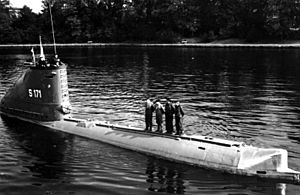German submarine U-2329 facts for kids

Postwar photo of Hecht (S 171), (former Type XXIII submarine U-2367). An identical sister ship of U-2329.
|
|
Quick facts for kids History |
|
|---|---|
| Name | U-2329 |
| Ordered | 20 September 1943 |
| Builder | Deutsche Werft, Hamburg |
| Yard number | 483 |
| Laid down | 2 June 1944 |
| Launched | 11 August 1944 |
| Commissioned | 1 September 1944 |
| Fate |
|
| General characteristics | |
| Class and type | Type XXIII submarine |
| Displacement |
|
| Length |
|
| Beam |
|
| Draught | 3.66 m (12 ft) |
| Installed power |
|
| Propulsion |
|
| Speed |
|
| Range |
|
| Test depth | 180 m (590 ft) |
| Complement | 14–18 |
| Armament |
|
| Service record | |
| Part of: |
|
| Commanders: |
|
| Operations: |
|
| Victories: | None |
The German submarine U-2329 was a special kind of U-boat used by Nazi Germany's navy (the Kriegsmarine) during World War II. It was a smaller, faster type of submarine called a Type XXIII submarine.
The order to build U-2329 was given on September 20, 1943. Construction began on June 2, 1944, at Deutsche Werft in Hamburg. The submarine was launched into the water on August 11, 1944. It officially joined the navy on September 1, 1944, under the command of Leutnant zur See Heinrich Schlott.
Contents
Submarine Design and Features
Like all Type XXIII U-boats, U-2329 was designed to be compact and efficient. It was smaller than many other submarines of its time.
Size and Weight
When U-2329 was on the surface, it weighed about 234 tonnes (230 long tons). When it was underwater, its weight increased to 258 tonnes (254 long tons). The submarine was about 34.68 meters (113 feet 9 inches) long overall. Its widest part was 3.02 meters (9 feet 11 inches) across. The part of the submarine that sat below the water (its draught) was 3.66 meters (12 feet) deep.
Engines and Speed
U-2329 had a powerful engine system. It used one MWM six-cylinder diesel engine for moving on the surface. This engine could produce between 575 and 630 horsepower. For moving underwater, it had two electric motors. One was a strong AEG electric motor that produced 580 horsepower. The other was a special BBC electric motor that produced 35 horsepower. This smaller motor allowed the submarine to move very quietly.
The submarine could travel at a maximum speed of 9.7 knots (18.0 km/h; 11.2 mph) when on the surface. Underwater, it could reach a speed of 12.5 knots (23.2 km/h; 14.4 mph).
Travel Range and Depth
U-2329 could travel long distances. On the surface, it could go about 2,600 nautical miles (4,800 km; 3,000 mi) at a speed of 8 knots (15 km/h; 9.2 mph). Underwater, it could travel about 194 nautical miles (359 km; 223 mi) at a slower speed of 4 knots (7.4 km/h; 4.6 mph). The submarine was built to withstand pressure down to a test depth of 180 meters (590 feet).
Crew and Weapons
The crew of U-2329 was quite small, usually between 14 and 18 sailors. This type of U-boat did not have a large gun on its deck. Instead, its main weapons were two torpedo tubes located at the front (bow). It could carry two torpedoes, which were preloaded and ready to fire.
Service History and Fate
U-2329 served in the German navy during the final months of World War II.
Joining the Flotillas
From September 1, 1944, to March 14, 1945, U-2329 was part of the 32nd U-boat Flotilla. After that, from March 15 to May 8, 1945, it joined the 11th U-boat Flotilla. During its time in service, it completed one patrol between April 11 and April 26, 1945. It did not sink any enemy ships during this patrol.
Surrender and Sinking
As World War II was ending, U-2329 surrendered to the Allied forces on May 9, 1945, in Stavanger, Norway. In June 1945, it was moved to Loch Ryan, Scotland.
U-2329 was one of 116 German U-boats chosen for Operation Deadlight. This was a plan by the Allies to sink the surrendered U-boats so they could not be used again. On November 28, 1945, U-2329 was towed out to sea. It was then sunk by gunfire from the British destroyer HMS Onslow and the Polish destroyer ORP Piorun. The wreck of U-2329 now lies at 56°10′N 10°05′W / 56.167°N 10.083°W.
See also

